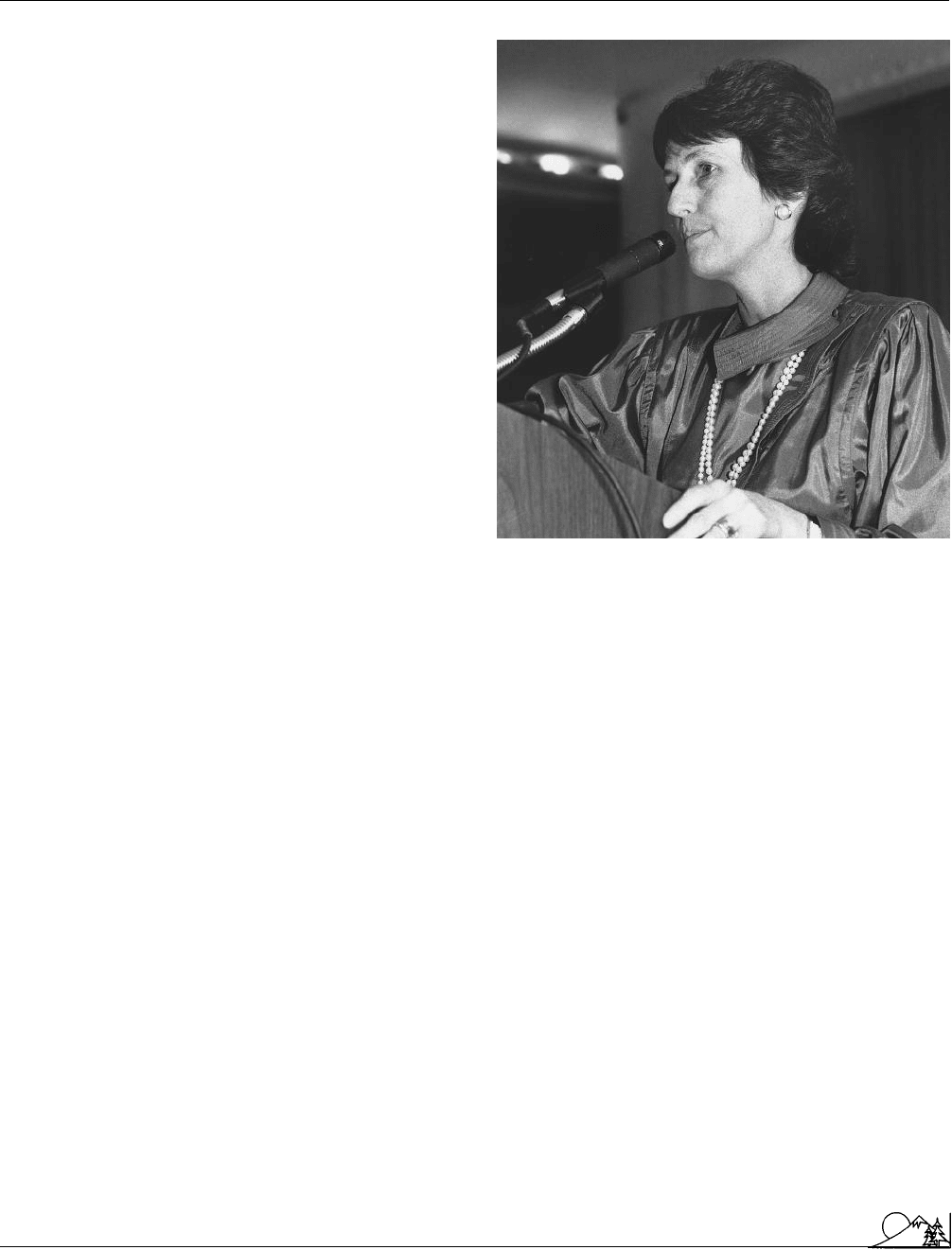Environmental Encyclopedia
Подождите немного. Документ загружается.


Environmental Encyclopedia 3
Bycatch reduction devices
Pacific Ocean fishery killed more than 100,000 dolphins a
year. That number dropped to an estimated 20,000 after
1972, when the Marine Mammals Protection Act was
passed. By 1989, the number was estimated at 12,643, largely
because the number of boats in the U.S. tuna fishing fleet
declined and those that were in operation killed fewer dol-
phins. U.S. fishing boats are now required to use techniques
that allow dolphins to escape from tuna nets before the catch
is hauled in. These include having fishermen jump into the
ocean to hold the lip of the net below the water surface so
the dolphin can jump out.
[David Clarke]
197
R
ESOURCES
B
OOKS
Decline of the Sea Turtles, Causes and Prevention. Washington, D.C.: Na-
tional Academy Press, 1990.
Dolphins and the Tuna Industry. Washington, D.C.: National Academy
Press, 1992.
Managing the Nation’s Bycatch: Priorities, Programs and Actions for the Na-
tional Marine Fisheries Service. Washington, D.C.: National Marine Fisher-
ies Service, National Oceanic and Atmospheric Administration, U.S. De-
partment of Commerce, March 20, 1997.
This Page Intentionally Left Blank

C
Cadmium
A metallic element that occurs most commonly in
nature
as the sulfide, CdS. Cadmium has many important industrial
applications. It is used to electroplate other metals, in the
production of paints and
plastics
, and in nickel-cadmium
batteries. The metal also escapes into the
environment
during the burning of
coal
and
tobacco
. Cadmium is ubiq-
uitous in the environment, with detectable amounts present
in nearly all water, air, and food samples. In high doses,
cadmium is toxic. In lower doses, it may cause kidney disease,
disorders of the circulatory system, weakening of bones, and,
possibly,
cancer
. See also Itai-Itai disease
CAFE
see
Corporate Average Fuel Economy
standards
Cairo conference
The 1994 International Conference on Population and De-
velopment occurs at a defining moment in the history of
international cooperation, the preamble to the Program of
Action for the United Nations International Conference
on Population and Development (UN ICPD) stated. This
historic conference, the fifth such world meeting regarding
population issues, was held in Cairo, Egypt September 5th
to 13th, 1994, at a time when there was growing, world-
wide recognition of the interdependence between global
population, development and
environment
. The Cairo
Conference considered itself as building upon the foundation
already laid in the 1974 World Population Conference in
Bucharest and the 1984 International Conference on Popu-
lation in Mexico City.
Representatives from 180 countries throughout the
world gathered to discuss these problems. In order to repre-
sent particular world societal blocs, the UN ensured repre-
199
sentation from four communities of nations: developing
countries, Muslim states, the industrialized West, and Cath-
olic countries. The makeup of attending blocs was inten-
tional, as controlling the world’s population involves many
hotly debated issues that bring about sharp differences of
opinion on religious and cultural beliefs. Conference atten-
dees and those that would follow up on the conference’s
recommendations in their host nations would have to address
issues like marriage, divorce, abortion, contraception and
homosexuality.
The call to address
population growth
came at a
time when some groups said that the world was already
pushing its food supply to natural limits. For example, ma-
rine biologists stated that ocean fisheries could not sustain
catches upwards of 100 million tons of fish per year. Yet,
that level was reached in 1989. Seafood prices have continued
to rise since that time but seafood production has continued
and so has population growth. In many countries, under-
ground water supplies are reportedly strained and farming
has been exploited to its capacity. The world population was
estimated that year at 5.6 billion people, and projected to
continue to increase at the 1994 level of 86 million people
per year. Most frightening of all were the United Nations
population projections for the twenty years to follow. These
estimates ranged between 7.9 billion to 11.9 billion people
inhabiting the earth by 2014.
In his opening address on September 5, UN Secretary-
General Boutros-Boutros-Ghali said,
The efficacy of the
economic order of the planet on which we live de-
pended in great measure on the conference’s outcome.
.
Leaders of several countries spoke of the many issues sur-
rounding the problem and causing social and ethical dilem-
mas in setting population policy. Vice-President Albert Gore
of the United States spoke of a
holistic
approach that also
comprehensively addresses world poverty. Over the course
of six days, more than 200 speakers shared their concerns
about population and strategies to curb growth. Because the
conference was mandated to address the issues and how they
impacted population, the debate branched out to a number

Environmental Encyclopedia 3
Cairo conference
of economic, reproductive, trade, environmental, family
structure, healthcare, and education issues.
The following areas of need were spelled out in the
UN ICPD
Programme of Action
:
O
Rapid urbanization and movement within and across bor-
ders are additional population problems the Cairo confer-
ence attempted to address. At that time, more than 93
percent of the 93 million people added to the population
each year lived in developing countries. UN data just prior
to the conference also showed that 43 percent of the world
population resided in urban areas, up from 38 percent
in 1975.
O
The conference’s delegates agreed on common objectives
for controlling the world’s population and even took on
a more ambitious goal of population growth limit than
anticipated by some. The conference objectives are targeted
for completion by the year 2015. The common strategy
limits family size and helps empower women to participate
in reproductive decisions.
O
The Cairo conference goals also addressed some
mortality
issues, and set an objective of reducing infant mortality
worldwide by 45%. In 1994, infant mortality averaged 62
per 1,000 live births. The conference’s objective aimed to
lower that number to only 12 per 1,000 live births.
O
A goal was also outlined to lower maternal mortality to
30 per 100,000 women. These objectives would be fur-
thered by a pledge to offer prenatal care to all pregnant
women.
O
The conference also included an objective addressing edu-
cation. It outlined that all children of school age be enabled
to complete primary education.
O
Contraception availability became another tool to limit
population growth. The delegates settled on a goal of mak-
ing contraception accessible to 70% of the world’s popula-
tion by the year 2015. However, they also added universal
access to
family planning
as a final objective.
O
In order to meet family planning goals, some leaders in
the field suggested a shift in how leaders looked at their
policies. Prior to the conference, they tended to focus on
organized family planning programs. The Cairo conference
objectives shifted the focus to a broadened policy, con-
cerned with issues like gender equality, education, and
empowerment of women to better deal with reproductive
choices.
O
The aging of the populations in more developed countries
was also discussed.
Although unprecedented agreement was reached over
the few days in Cairo, it didn’t happen without heated debate
and controversy. Most participants supported the notion that
population policies must be based on individual rights and
freedom of choice, as well as the rights of women and cul-
200
tures. Since abortion was considered such a sensitive issue,
many delegates agreed that family planning offered women
alternative recourse to abortion. The Cairo Conference
ended with both hope and concern for the future. If the
conference objectives were reached, the delegates projected
that world population would rise from 5.7 billion in the
mid-1990s to 7.5 billion by the year 2015, and then begin
to stabilize. However, if the objectives were not reached,
conference attendees concluded that the population would
continue to rise to the perilous numbers discussed in the
conferences preamble.
Following the Cairo conference, the United States
began implementing the conference objectives. The U.S.
Agency for International Development (USAID) held a se-
ries of meetings between September 1994 and January 1995
to draw upon the expertise and ideas of American leaders
in the field and to begin encouraging U.S. participation in
population control goals. Among the USAID’s own objec-
tives for the United States were new initiatives and expansion
of programs in place that emphasized family planning and
health, as well as education and empowerment of women
in America. For example, USAID suggested expanding ac-
cess to reproductive health information and services and
improved prevention of HIV/AIDS and other sexually trans-
mitted diseases (STDs). It also promoted research on male
methods of contraception and new barrier methods to pro-
tect from both pregnancy and STDs. The agency focused
on improving women’s equality and rights beginning with
review of existing U.S. programs. A major focus would also
include improving women’s economic equity in the United
States.
Such initiatives cost money. The U.S. Congress appro-
priated $527 million to family planning and reproductive
health in fiscal year 1995 alone. A number of additional
programs received substantial funding to support the eco-
nomic, social, and educational programs needed to complete
the United States’ objectives related to the Cairo conference.
Included in this overall program was establishment of the
President’s Council on
Sustainable Development
, a com-
bination public/private group charged with making recom-
mendations on U.S. policies and programs that will help
balance population growth with consumption of
natural
resources
. The United States also worked cooperatively
with Japan prior to and following the conference on a com-
mon agenda to coordinate population and health assistance
goals. The program also was designed to help strengthen
relations between Japan and the United States.
Five years after the Cairo conference, a follow-up con-
ference was held in New York City from June 30th to July
2nd, 1999. In preparation for the conference, a forum was
held at The Hague, Netherlands. At that forum, delegates
of several countries that had expressed concerns about the

Environmental Encyclopedia 3
Dr. Helen Mary Caldicott
Cairo conference objectives five years earlier began trying
to renegotiate the program of action. By the time the
Cairo
Plus Five
conference convened in 1999, final recommenda-
tions had not been completed, as some member delegates,
including representatives of the Vatican in Rome, attempted
to alter the original Cairo program of action. Money was yet
another issue in focus at the 1999 meeting. United Nations
Population Fund (UNPFA) Chief Nafis Sadik estimated
that $5.7 billion per year was needed to meet the Cairo
Conference aims, an amount she described as
peanuts
. The
actual average amount available to the
Programme of Ac-
tion
was far less, $2.2 billion.
The real measure of success lies in whether or not
world population stabilizes. There is some evidence to sug-
gest that while still growing, the number of human beings
inhabiting this planet is not growing at the nightmare rates
projected at the beginning of the Cairo Conference. The
United States Bureau of Census projections, revised in 1999,
now estimate a world population of 8 billion by 2024, ap-
proximately the lowest estimate the Cairo Conference pro-
jected for 2014.
[Joan M. Schonbeck]
R
ESOURCES
P
ERIODICALS
US Census BureauWorld Population Profile: 1998--Highlights (revised
March 18,1999)
United NationsProgramme of Action of the UN ICPD, Preamble
United Nations Chronicle, On-Line EditionPopulation, Progress and Pea-
nutsVol.XXXVI, Nov.3, 1999, Dept. of Information
“Focus on Population and Development: Follow-up on Cairo Confer-
ence.”US Department of State Dispatch6, no. 1 (January 2, 1995): 4.
“Cairo Conference Reaches Consensus on Plan to Stabilize World Growth
by 2015.”UN Chronicle31 (December 1994): 63.
O
RGANIZATIONS
Population Council, 1 Dag Hammarsrkjold Plz, New York, NY USA
10017 (212) 339-0500, Fax: (212) 755-6052, Email: pubinfo@popinfo.org,
<http://www.popcouncil.org>
United Nations, , New York, NY USA 10017 , <http://www.un.org>
Calcareous soil
A calcareous
soil
is soil that has calcium carbonate (CaCO
3
)
in abundance. If a calcareous soil has hydrochloric
acid
added to it, the soil will effervesce and give off
carbon
dioxide
and form bubbles because of the chemical reaction.
Calcareous soils are most often formed from limestone or
in dry environments where low rainfall prevents the soils
from being leached of carbonates. Calcareous soils frequently
cause
nutrient
deficiencies for many plants.
201
Dr. Helen Mary Caldicott (1938 – )
Australian physician and activist
Dr. Helen Caldicott is a pediatrician, mother, antinuclear
activist, and environmental activist. Born Helen Broinowski
in Melbourne,
Australia
on August 7, 1938, she is known
as a gifted orator and a tireless public speaker and educator.
She traces her activism to age 14 when she read Nevil Shute’s
On the Beach, a chilling novel about nuclear holocaust. In
1961 she graduated from the University of Adelaide Medical
School with bachelor of medicine and bachelor of surgery
degrees, which are the equivalent of an American M.D. She
married Dr. William Caldicott in 1962, and returned to
Adelaide, Australia to go into general medical practice. In
1966 she, her husband, and their three children moved to
Boston, Massachusetts, where she held a fellowship at Har-
vard Medical School. Returning to Australia in 1969, she
served first as a resident in pediatrics and then as an intern
in pediatrics at Queen Elizabeth Hospital. There, she set
up a clinic for cystic
fibrosis
, a genetic disease in children.
In the early 1970s, Caldicott led a successful campaign
in Australia to ban atmospheric nuclear testing by the French
in the South Pacific. Her success in inspiring a popular
movement to stop the French testing has been attributed to
her willingness to reach out to the Australian people through
letters and television and radio appearances, in which she
explained the dangers of
radioactive fallout
. Next, she led
a successful campaign to ban the exportation of
uranium
by
Australia. During that campaign she met strong
resistance
from Australia’s government, which had responded to the
1974 international
oil embargo
by offering to sell uranium
on the world market. (Uranium is the raw material for nu-
clear technology.) Caldicott chose to go directly to mine
workers, explaining the effects of radiation on their bodies
and their genes and talking about the effects of nuclear
war on them and their children. As a result, the Australian
Council of Trade Unions passed a resolution not to mine,
sell, or transport uranium. A ban was instituted from 1975
to 1982, when Australia gave in to international pressure to
resume the exportation.
In 1977 Dr. Caldicott and her husband immigrated to
the United States, accepting appointments at the Children’s
Hospital Medical Center and teaching appointments at Har-
vard Medical School in Boston, Massachusetts. She was a
co-founder of Physicians for Social Responsibility (PSR),
and she was its president at the time of the March 28, 1979
nuclear accident at the
Three Mile Island Nuclear Reactor
in Pennsylvania. At that time, PSR was a small group of
concerned medical specialists. Following the accident, the
organization grew rapidly in membership, financial support,
and influence. As a result of her television appearances and
statements to the media following the Three Mile Island

Environmental Encyclopedia 3
Lynton Keith Caldwell
accident, Caldicott became a symbol of the movement to
ban all
nuclear power
and oppose
nuclear weapons
in
any form. Ironically, she resigned as president of PSR in
1983, when the organization had grown to over 20,000
members. At that time, she began to be viewed as an extreme
radical in an organization that had become more moderate
as it came to represent a wide, diversified membership.
She also founded Women’s Action for Nuclear Disar-
mament (WAND). WAND has been an effective group
lobbying Congress against nuclear weapons.
Throughout her career, Caldicott has considered her
family to be her first priority. She has three children and
she emphasizes the importance of building and maintaining
a strong marriage, believing that good interpersonal relation-
ships are essential before a socially-minded person can work
effectively for broad social change.
Caldicott has developed videotapes and films and has
written over one hundred articles which have appeared in
major newspapers and magazines throughout the world. She
has written four books. Her first, Nuclear Madness: What
You Can Do (1978) is considered important reading in the
antinuclear movement. Her second, entitled Missile Envy,
was published in 1986. In If You Love This Planet: A Plan
to Heal the Earth (1992), Caldicott discusses the race to save
the planet from environmental damage resulting from excess
energy consumption,
pollution
,
ozone layer depletion
,
and global warming. She urges citizens of the United States
to follow the example set by the Australians, who have
adopted policies and laws designed to move their society
toward greater corporate and institutional responsibility. She
urges the various nations of the world to strive for a “new
legal world order” by moving toward a sort of transnational
control of the world’s
natural resources
. One of her books,
A Desperate Passion, (1996) is an autobiography in which
she reflects upon crucial events that have influenced her and
talks about people who have inspired her in her life and
work. Her latest work was entitled The New Nuclear Danger:
George Bush’s Military Industrial Complex (2002).
Caldicott is the recipient of many awards and prizes
including the SANE Peace Prize, the Ghandi Peace Prize,
the John-Roger Foundation’s Integrity Award (which she
shared with Bishop Desmond Tutu), the Norman Cousins
Award for Peace-making, the Margaret Mead Award, and
many others.
[Paulette L. Stenzel]
R
ESOURCES
B
OOKS
Caldicott, H. If You Love This Planet: A Plan to Heal the Earth. New York:
W. W. Norton, 1992.
———. Missle Envy. New York: Bantam Books, 1986.
202
Dr. Helen Caldicott. (Corbis-Bettmann. Reproduced by
permission.)
———. Nuclear Madness: What You Can Do. New York: Bantam Books,
1981.
———. The New Nuclear Danger: George Bush’s Military Industrial Complex.
The New Press, 2002.
Caldicott, H. A Desperate Passion. New York: Bantam Books, 1996.
P
ERIODICALS
Nixon, W. “Helen Caldicott: Practicing Global Preventive Medicine.” E
Magazine (September–October 1992): 12–5.
Lynton Keith Caldwell (1913 – )
American scholar and environmentalist
Lynton Caldwell has been a key figure in the development
of
environmental policy
in the United States. A longtime
advocate for adding an environmental amendment to the
Constitution, Caldwell has insisted that the federal govern-
ment has a duty to protect the
environment
that is akin to
the defense of civil rights or freedom of speech.
Caldwell was born November 21, 1913 in Montezuma,
Iowa. He received his bachelor of arts from the University
of Chicago in 1935 and completed a master of arts at Harvard
University in 1938. The same year, Caldwell accepted an
assistant professorship in government at Indiana University
in Bloomington. In 1943, he attained his doctorate from
the University of Chicago and began publishing academic

Environmental Encyclopedia 3
California condor
works the following year. The subjects of his early writings
were not environmental; he published a study of administra-
tive theory in 1944 and a study of New York state govern-
ment in 1954. By 1964, however, Caldwell had shifted his
emphasis, and he began to receive wide recognition for his
work on environmental policy. In that year, he was presented
with the William E. Mosher Award from the American
Society for Public Administration for his article “Environ-
ment: A New Focus for Public Policy.”
Caldwell’s most important accomplishment was his
prominent role in the drafting of the
National Environmen-
tal Policy Act
(NEPA) in 1969. As a consultant for the
Senate Committee on Interior and Insular Affairs in 1968,
he prepared A Draft Resolution on a National Policy for the
Environment. His special report examined the constitutional
basis for a national environmental policy and proposed a
statement of intent and purpose for Congress. Many of the
concepts first introduced in this draft resolution were later
incorporated into the act. As consultant to that committee,
Caldwell played a continuing role in the shaping of the
NEPA, and he was involved in the development of the
environmental impact statement
.
In past years Caldwell has strongly defended the
NEPA, as well as the regulatory agency it created, claiming
that they represent “the first comprehensive commitment
of any modern state toward the responsible custody of its
environment.” Although the act has influenced policy deci-
sions at every level of government, the enforcement of its
provisions have been limited. Caldwell argues that this is
because environmental regulations have no clear grounding
in the law. Statutes alone are often unable to withstand
the pressure of economic interests. He has proposed an
amendment to the Constitution as the best practical solution
to this problem and he maintains that without such an
amendment, environmental issues will continue to be mar-
ginalized in the political arena.
In addition to advising the Senate during the creation
of the NEPA, Caldwell has done extensive work on interna-
tional environmental policy. He has advised the Central
Treaty Organization and served on special assignments in
countries including Colombia, India, the Philippines, and
Thailand. Currently, Caldwell serves as the Arthur F. Bent-
ley Professor of Political Science emeritus and professor of
public and environmental affairs at Indiana University in
Bloomington, Indiana.
[Douglas Smith]
R
ESOURCES
B
OOKS
Metzger, L., ed. “Caldwell, Lynton.” In Contemporary Authors New Revision
Series. Vol. 12. Detroit: Gale Research, 1984.
203
P
ERIODICALS
Caldwell, L. K. “20 Years with NEPA Indicate the Need.” Environment
31 (December 1989): 6–11, 25–28.
California condor
With a wingspan of over 9 ft (about 3 m), the California
condor (Gymnogyps californianus) has the largest wingspan
of any bird in North America. The condor is a
scavenger
.
It is a member of the New World vulture family (Catharti-
dae), and is closely related to the Andean condor found in
South America.
The California condor is an
endangered species
barely avoiding
extinction
. While the condor population
may have been in decline before the arrival of Europeans in
North America, increased settlement of its
habitat
,
hunt-
ing
, and indirect human influences (
pollution
, pesticides,
construction hazards such as power lines) have almost wiped
out the bird.
The condor was once found in much of North
America. Fossil records indicate that it lived from Florida
to New York in the East and British Columbia to Mexico
in the West. The condor’s range became more restricted
even before European settlers arrived in North America. By
the time Columbus arrived in North America (mid-fifteenth
century), the condor had already started its retreat west. At
the beginning of the twentieth century it could still be found
in southern California and Baja California (northern Mex-
ico), but by 1950 its range had been reduced to a strip of
about 150 mi (241 km) at the southern end of the San
Joaquin Valley in California.
In the 1940s, the
National Audubon Society
initi-
ated a census of the condor population and recorded approxi-
mately 60 birds. In the early 1960s, the population was
estimated at 42 birds. A 1966 survey found 51 condors, an
increase that may have been due to variability among the
sampling systems used. By the end of 1986 there were 24
condors alive, 21 of which were in captivity.
Direct and indirect human stressors are directly re-
sponsible for the decline in the condor population during
the past three centuries. California condors have been shot
by hunters and poisoned by bait set out to kill coyotes. Their
food has been contaminated with pesticides such as DDT
or
lead
from
lead shot
found in animal carcasses shot and
lost by hunters. The condor’s rarity has made their eggs a
valuable commodity for unscrupulous collectors. Original
food sources, such as mammoths and giant camels of the
Pleistocene era, have disappeared, but as cattle ranching and
sheep farming developed, carcasses of these animals have
become suitable substitutes. Habitat destruction and general
harassment reduced the condor’s range and population to a

Environmental Encyclopedia 3
John Baird Callicot
California condor (
Gymnogyps californianus
).
(Photograph by Roy Toft. Tom Stack & Associates. Repro-
duced by permission.)
point where intervention was necessary to halt the bird’s
rapid decline to extinction.
Most other large birds and mammals in North
America that lived during the late Pleistocene period have
become extinct. However, there is a small chance that with
intervention and restoration projects, the California condor
can be saved from extinction. As a result, after much debate,
the decision was made to remove all California condors from
the wild and initiate a captive breeding and reintroduction
program. The United States
Fish and Wildlife Service
,
together with the California Fish and Game Commission,
captured the last wild condor in April 1987.
The captive breeding program has thus far increased
the condor population dramatically. Condors nest only once
every two years and typically lay only one egg. By removing
the egg from the nest for laboratory incubation, the female
can be tricked into laying a replacement egg. This helps
accelerate the population increase.
In January 1992, a pair of California condors was
released into the wild. In October the male was found dead
of kidney failure after apparently drinking from a pool of
antifreeze in a parking lot near their sanctuary. Six additional
condors were released at the end of 1992. In 1994, the total
condor population consisted of nine wild condors and 66
birds in captivity. In 1995 another pair of captive birds was
released into the wild, and with the release of more birds
in following years, breeding pairs began to establish nest
sites. In 2001, an egg that was laid by captive condors in
the Los Angeles Zoo was placed in a condor nest in the
wild, and the chick hatched successfully, only to die a few
days later. The pair of condors then laid their own egg and
hatched the first wild chick in April 2002. This was the first
chick hatched in the wild in 18 years. As of April 2002,
204
there were 63 free-living condors in California and Arizona
and 18 more were awaiting release from field pens where
they were being acclimated to their natural habitat. The
captive population totaled 104 birds.
The California Condor Recovery Plan is a consortium
of private groups and public agencies. The goal of the recov-
ery plan is to have 150 condors in each of two separate
populations with at least 15 breeding pairs in each group.
However, there are significant obstacles to the recovery of
wild populations of California condors. These include con-
tinued pressure from development that causes accidents such
as collisions with power lines and
poisoning
by crude oil
from drilling operations that the birds mistake for pools of
water. Although the capture and release of this
species
is
working and the population of captive birds is growing, the
survival of the California condor in the wild is still in doubt.
Measures must be taken to reduce risks to wild birds from
man-made hazards.
[Eugene C. Beckham and Marie H. Bundy]
R
ESOURCES
B
OOKS
Darlington, D. In Condor Country: A Portrait of a Landscape, Its Denizens
and Its Defenders. New York: Henry Holt, 1991.
Snyder, N. F. R., and H. A. Snyder. “Biology and Conservation of the
California Condor.” In Current Ornithology, Vol. 6, edited by D. M. Power.
New York: Plenum, 1989.
P
ERIODICALS
Jurek, R. M. “An Historical Review of California Condor Recovery Pro-
grammes.” Vulture News 23 (1990):3–7.
Kiff, L. “To the Brink and Back: The Battle to Save the California Condor.”
Terra 28 (1990):6–18.
Willwerth, J. “Can They Go Home Again?” Time 139 (27 January
1992):56–57.
John Baird Callicot (1941 – )
American environmental philosopher
J. Baird Callicott is a founder and seminal thinker in the
modern field of environmental philosophy. He is best known
as the leading contemporary exponent of Aldo Leopold’s
land ethic
, not only interpreting Leopold’s original works
but also applying the reasoning of the land ethic to modern
resource issues such as
wilderness
designation and
biodiv-
ersity
protection.
Callicott’s 1987 edited volume, Companion to A Sand
County Almanac, is the first interpretive and critical discus-
sion of Leopold’s classic work. His 1989 collection of essays,
In Defense of the Land Ethic, explores the intellectual founda-
tions and development of Leopold’s ecological and philo-
sophical insights and their ultimate union in his later works.

Environmental Encyclopedia 3
Canadian Forest Service
In 1991 Callicott, with Susan L. Flader, introduced to the
public the best of Leopold’s remaining unpublished and
uncollected literary and philosophical legacy in a collection
entitled The River of the Mother of God and Other Essays by
Aldo Leopold
.
Since his contribution to the inaugural issue of the
journal Environmental Ethics in 1979, Callicott’s articles and
essays have appeared not only in professional philosophical
journals and a variety of scientific and technical periodicals,
but in a number of lay publications as well. He has contrib-
uted chapters to more than twenty books and is internation-
ally known as an author and speaker. Born in Memphis,
Tennessee, Callicott completed his Ph.D. in philosophy at
Syracuse University in 1971, and has since held visiting
professorships at a number of American universities. In 1971,
while teaching at the University of Wisconsin-Stevens Point,
Callicott designed and taught what is widely acknowledged
as the nation’s first course in
environmental ethics
.Heis
currently associate professor of Philosophy and Religion at
the University of North Texas. With respect to the major
value questions today in environmental ethics, Callicott’s
position can best be illustrated by his claim that there can
be no value without valuers. He thus recognizes the legiti-
macy of both instrumental and intrinsic valuation on the
part of a democracy of valuers, human and nonhuman.
Callicott perceives that we live today on the verge of
a profound paradigm shift concerning human interactions
with and attitudes toward the natural world. Much of his
current work aims at distilling and giving voice to this shift
and at articulating an ecologically accurate and philosophi-
cally valid concept of sustainability. This concept abandons
dualistic (man versus
nature
), ethnocentric (modern Eu-
roamerican), and static (e.g., wilderness frozen in time) ele-
ments of current thought in sustainability in favor of those
emphasizing dynamic human/nonhuman
mutualism
, both
in
ecosystem conservation
and in restoration. Through
careful management consistent with the best ecological in-
formation and theories, Callicott believes, humans can not
only protect but can and should enhance
ecosystem health
.
His ideas challenge modern conventional wisdom and could
radically alter much current theory in environmental philoso-
phy as well as affect practice in wilderness management and
economic development planning.
As one of a handful of scholars who launched the field
of environmental ethics as we know it today, and as one of
even fewer philosophers who have made their works accessi-
ble and pertinent not only to other academicians but to the
general public, J. Baird Callicott occupies an important place
in the history of modern philosophy. His work will undoubt-
edly continue to shape thinking on the ethical dimensions
of resource management decisions for generations to come.
[Ann S. Causey]
205
R
ESOURCES
B
OOKS
Callicott, J. B. Companion to A Sand County Almanac. Madison: University
of Wisconsin Press, 1987.
———. In Defense of the Land Ethic: Essays in Environmental Philosophy.
Albany: State University of New York Press, 1989.
———. Nature in Asian Tradition of Thought: Essays in Environmental
Philosophy. Albany: State University of New York Press, 1989.
Campephilus principalis
see
Ivory-billed woodpecker
Canadian Forest Service
The Canadian
Forest Service
(CFS) is a federal government
agency with a responsibility to conduct research and analyze
information related to the sustainable use of the Canadian
forest resource. Because of the importance of the forest
industries to the Canadian economy, CFS is a department
with its own minister in the federal cabinet.
In Canada, provincial and territorial governments have
the responsibility for establishing allowable forest harvests
and establishing criteria for acceptable management plans
for provincial-crown land, which comprises the bulk of the
economic forest resource of the nation. CFS integrates with
relevant departments of the provinces and territories through
the Canadian Council of Forest Ministers.
CFS operates six forest research centers in the regions
of Canada, as well as two research institutes: the Petawawa
National Forestry Institute at Chalk River, Ontario, and
the Forest
Pest
Management Institute at Sault Ste. Marie,
Ontario. Collectively, these institutions and their staff com-
prise the major force in forestry-related research in Canada.
The Government of Canada has committed to the
practice of ecologically
sustainable forestry
, and CFS
works with other levels of government, industry, educational
institutions, and the public towards this end.
Research programs within CFS are diverse, and in-
clude activities related to tree anatomy, physiology, and pro-
ductivity, techniques of
biomass
and stand inventory, deter-
mination of site quality, and research of forest harvesting
practices, management practices aimed at increasing produc-
tivity and economic value, and forest pest management.
CFS also supports much of the
forest management
and research conducted within each of the provinces and
territories, through joint federal-provincial Forest Develop-
ment Agreements. CFS also supports much of the forestry
research conducted at Canadian universities through re-
search contracts and joint-awards programs with other gov-
ernment agencies and industry.

Environmental Encyclopedia 3
Canadian Parks Service
An important initiative, begun in 1992, is the Model
Forest Program under Canada’s Green Plan. The intent of
this program is to provide substantial support for innovative
forest management and research, conducted by integrated
teams of partners involving industry, all levels of government,
universities, non-government organizations, woodlot own-
ers, and other groups and citizenry. A major criterion for
success in the intense competition for funds towards a model
forest is that the consortium of proponents demonstrate a
vision of ecologically sustainable forest management, and a
likely capability of achieving that result.
CFS’s most recent endeavor is titles Forest 2020. This
project was established at the 2001 Annual Meeting of Cana-
dian Council of Forest Ministers (CCFM), and revolves
around “incorporating wood fibre production through the
establishment of plantations of fast growing high-yield tree
species
, and intensified silviculture in previously harvested,
or second growth, forest areas.”
[David A. Duffus and Amy Strumolo]
R
ESOURCES
B
OOKS
The State of Canada’s Forests, 1991. Second Report to Parliament. Ottawa:
Canadian Forest Service, 1992.
O
RGANIZATIONS
Canadian Forest Service, Natural Resources Canada, 580 Booth Street,
8th Floor, Ottawa, OntarioCanada K1A 0E4 (613) 947-7341, Fax: (613)
947-7397, Email: cfs-scf@nrcan.gc.ca, <http://www.nrcan-rncan.gc.ca/
cfs-scf>
Canadian Parks Service
The Canadian Parks Service (CPS) is the government agency
charged with fulfilling the statutes and policies of Canada’s
national parks. The first
national park
was established in
Banff, Alberta, in 1885, although parks were not institution-
alized in Canada until 1911. The original policy and program
established national parks to protect characteristic aspects
of Canada’s natural heritage, and, at the same time, cater
to the benefit, enjoyment, and education of its people.
The National Parks Act of 1930 required parliamen-
tary approval of parks, prohibited
hunting
, mining, and
exploration, and limited forest harvesting. Other federal stat-
utes gave control over lands and resources to the provinces,
which meant land assembly for park development could not
proceed without intergovernmental agreement. An amend-
ment to the Parks Act increased the Park Service’s ability
to enforce regulations and levy meaningful penalties.
In 1971 the park system was expanded to include
examples of all 39 terrestrial natural regions of Canada.
Currently, 25 regions are represented by 39 parks. The Cana-
206
dian government has pledged to develop sites in the re-
maining 14 regions in upcoming years. The CPS hopes
that national parks will eventually encompass 12 percent of
Canada’s land base; they currently occupy only 1.8 percent.
Canada’s four marine coasts have been classified into
29 regions, all of which are to be represented in a marine
parks program. One site has been formally established, while
four others are being considered. The CPS mandate was
amended in 1986 to share control of marine parks with two
other federal agencies, which manage fisheries and marine
transportation
.
Current park policy emphasizes the maintenance of
ecological integrity
over tourism and
recreation
. Much
conflict, however, has centered on development within park
boundaries. Townsites, highways, ski resorts, and
golf
courses
provide public enjoyment, but conflict with the
protective mandate of the parks’ charter. Commercial and
recreational fishing,
logging
, and
trapping
have also been
allowed, despite legal prohibitions. In 1992, the Canadian
Parks and
Wilderness Society
and the Sierra Legal Defense
Fund successfully sued the Canadian government to stop
logging in Wood Buffalo National Park, a protected
habitat
for both the endangered
whooping crane
and wood
bison
.
[Amy A. Strumolo]
Canadian Wildlife Service
The Canadian
Wildlife
Service (CWS) was established in
1947. Until 1971 it was governed by the federal government’s
Parks Branch in the Department of Indian and Northern
Development. Since 1971 it has been a branch of
Environ-
ment Canada
, most recently under the
Conservation
and
Protection division. The Service is served by five regional
offices across Canada and is headquartered in Hull, Quebec.
There are four branches within the CWS: the Migratory
Birds and Conservation Branch; the North American Wa-
terfowl Management Plan Implementation Branch; the
Wildlife Toxicology and Surveys Branch/National Wildlife
Research Centre; and the Program Analysis and Co-ordina-
tion Branch.
Wildlife matters were delegated to the provinces by
the Canadian constitution, and responsibility is generally in
the hands of provincial administrations. Federal-provincial
cooperation was facilitated through meetings of the Federal-
Provincial Wildlife Ministers Conferences, ongoing since
1922 and an annual event since 1945. Through those ongo-
ing discussions, federal wildlife policy has developed mainly
around areas of transboundary issues and problems deemed
in the national interest. Currently, the CWS’s primary re-
sponsibility is to enforce the Migratory Birds Convention
Act, the Canada Wildlife Act, the Convention on Interna-
